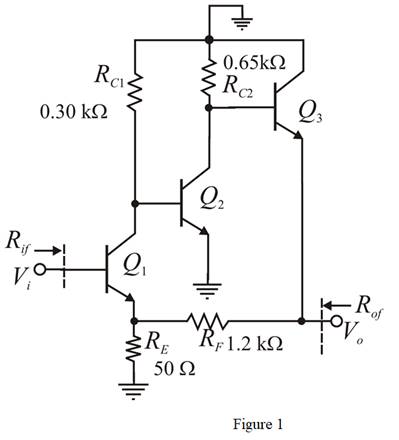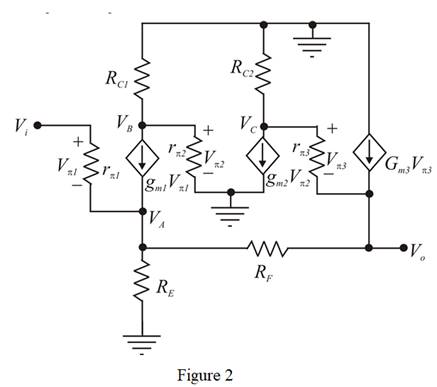
The circuit shown in Figure P12.38 is an ac equivalent circuit of a feedback amplifier. The transistor parameters are

Figure P12.38
(a)
The value of the closed loop voltage gain.
To compare: The approximate value with the ideal value of the closed loop gain.
Answer to Problem 12.38P
The value of closed loop gain is
Explanation of Solution
Given:
The given circuit is shown in Figure 1.

Calculation:
The small signal model of the given circuit is shown in Figure 2.

The expression for the small signal input resistance is given by,
Substitute
The expression for the trans-conductance of the first transistor is given by,
Substitute
The expression for the small signal input resistance is given by,
Substitute
The expression for the trans-conductance of the first transistor is given by,
Substitute
The expression for the small signal input resistance is given by,
Substitute
The expression for the trans-conductance of the first transistor is given by,
Substitute
The expression for the
Apply KCL at
Substitute
Substitute
Apply KCL at
Substitute
Substitute
Apply KCL at
Substitute
Substitute
Apply KCL at
Substitute
Substitute
Substitute
The approximate ideal value of the closed loop voltage gain is given by,
The closed loop voltage gain is by formula
Conclusion:
Therefore, the value of closed loop gain is
(b)
The value of the resistance
Answer to Problem 12.38P
The value
Explanation of Solution
Given:
The given circuit is shown in Figure 1.

Calculation:
Consider the equation for the voltage
Substitute
The expression for the current
Substitute
Substitute
Apply KCL at the output.
Substitute
The equation for the
Evaluate the equation of the voltage
Substitute
Substitute
Substitute
Conclusion:
Therefore, the value
Want to see more full solutions like this?
Chapter 12 Solutions
MICROELECT. CIRCUIT ANALYSIS&DESIGN (LL)
- Discuss the difference between the current series negative feedback amplifier and voltage shunt feedback amplifier in terms of output impedance, input impedance, voltage gain, bandwidth, distortion and noise.arrow_forwardA unity feedback system with open-loop transfer function given as:?(?) = ??. ?(? + ?)(? + ?)(? + ??)without affecting its operating point (−1.54 ∓ ??2.66) appreciably a- Design a suitable compensator to drive the step response error to zero.b- Design a suitable compensator to reduce step error by factor of 5.arrow_forwardCalculate the feedback gain AF value. RİF=? ROF=?arrow_forward
- A negative feedback closed loop system gain, y(t) /r(t) ), of at least 7.5 is needed with a ß = 0.1. a. What is the minimum value of the forward gain, 4, that will allow this? b. What is the loop gain for this system?arrow_forwardDefine feedback mechanism, and provide two examples.arrow_forwardFind the range of K using the Routh - Hurwitz method for the closed - loop stability of the negative unit feedback system given the open - loop transition function belowarrow_forward
- The input-output transfer function of the system shown in Figure 1 is used with the help of Mason gain formulation. specifyarrow_forwardConsider the unity-feedback system with the open loop transfer function:arrow_forwardWhy negative feedback is applied in high gain amplifiers? Discuss the principles of negative voltage feedback in amplifiers with a neat diagram.arrow_forward
 Introductory Circuit Analysis (13th Edition)Electrical EngineeringISBN:9780133923605Author:Robert L. BoylestadPublisher:PEARSON
Introductory Circuit Analysis (13th Edition)Electrical EngineeringISBN:9780133923605Author:Robert L. BoylestadPublisher:PEARSON Delmar's Standard Textbook Of ElectricityElectrical EngineeringISBN:9781337900348Author:Stephen L. HermanPublisher:Cengage Learning
Delmar's Standard Textbook Of ElectricityElectrical EngineeringISBN:9781337900348Author:Stephen L. HermanPublisher:Cengage Learning Programmable Logic ControllersElectrical EngineeringISBN:9780073373843Author:Frank D. PetruzellaPublisher:McGraw-Hill Education
Programmable Logic ControllersElectrical EngineeringISBN:9780073373843Author:Frank D. PetruzellaPublisher:McGraw-Hill Education Fundamentals of Electric CircuitsElectrical EngineeringISBN:9780078028229Author:Charles K Alexander, Matthew SadikuPublisher:McGraw-Hill Education
Fundamentals of Electric CircuitsElectrical EngineeringISBN:9780078028229Author:Charles K Alexander, Matthew SadikuPublisher:McGraw-Hill Education Electric Circuits. (11th Edition)Electrical EngineeringISBN:9780134746968Author:James W. Nilsson, Susan RiedelPublisher:PEARSON
Electric Circuits. (11th Edition)Electrical EngineeringISBN:9780134746968Author:James W. Nilsson, Susan RiedelPublisher:PEARSON Engineering ElectromagneticsElectrical EngineeringISBN:9780078028151Author:Hayt, William H. (william Hart), Jr, BUCK, John A.Publisher:Mcgraw-hill Education,
Engineering ElectromagneticsElectrical EngineeringISBN:9780078028151Author:Hayt, William H. (william Hart), Jr, BUCK, John A.Publisher:Mcgraw-hill Education,





